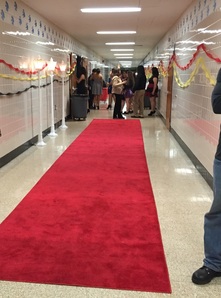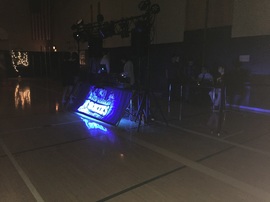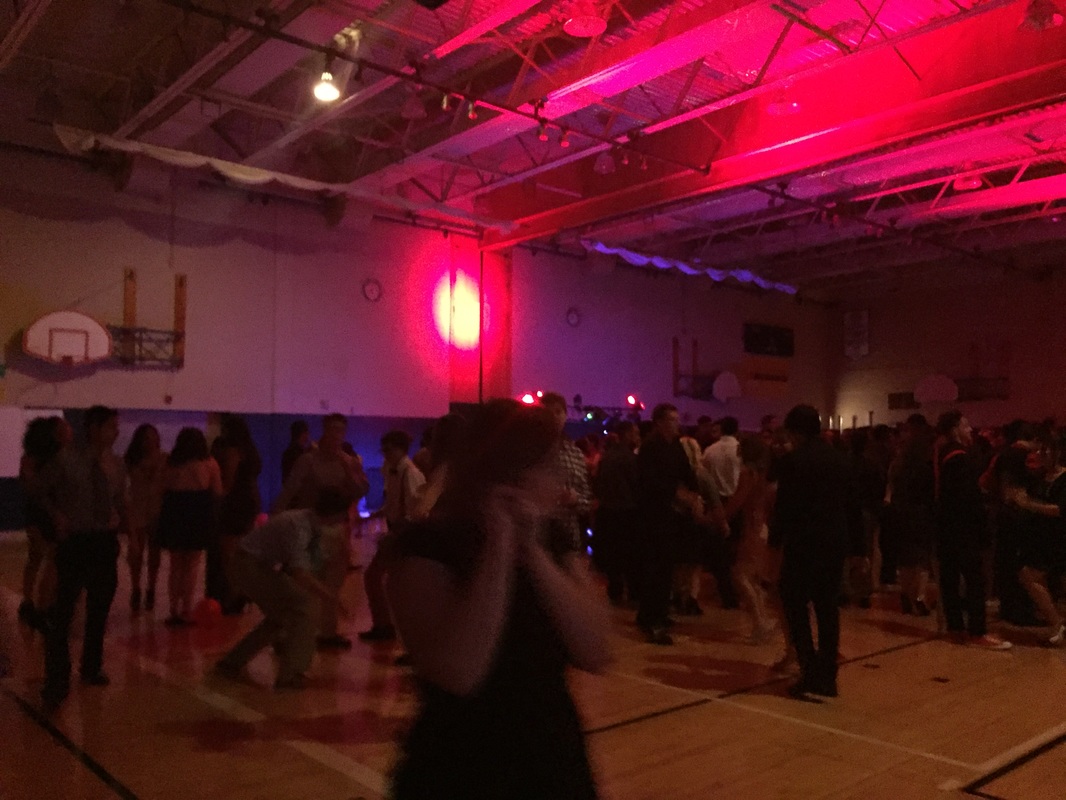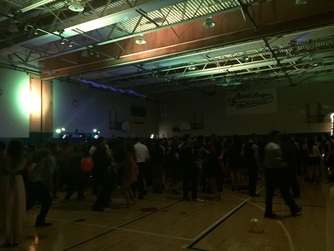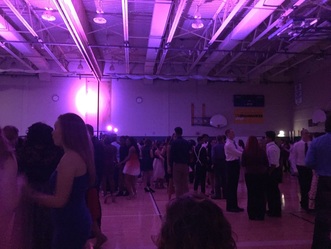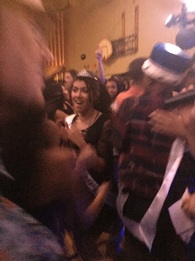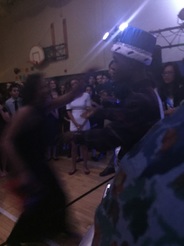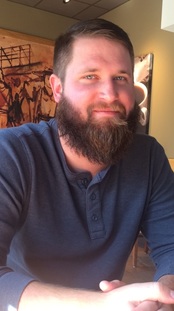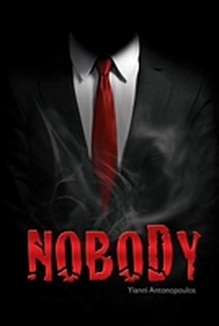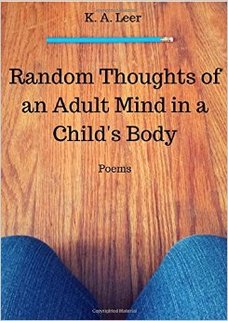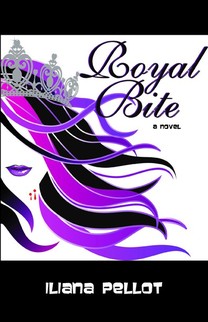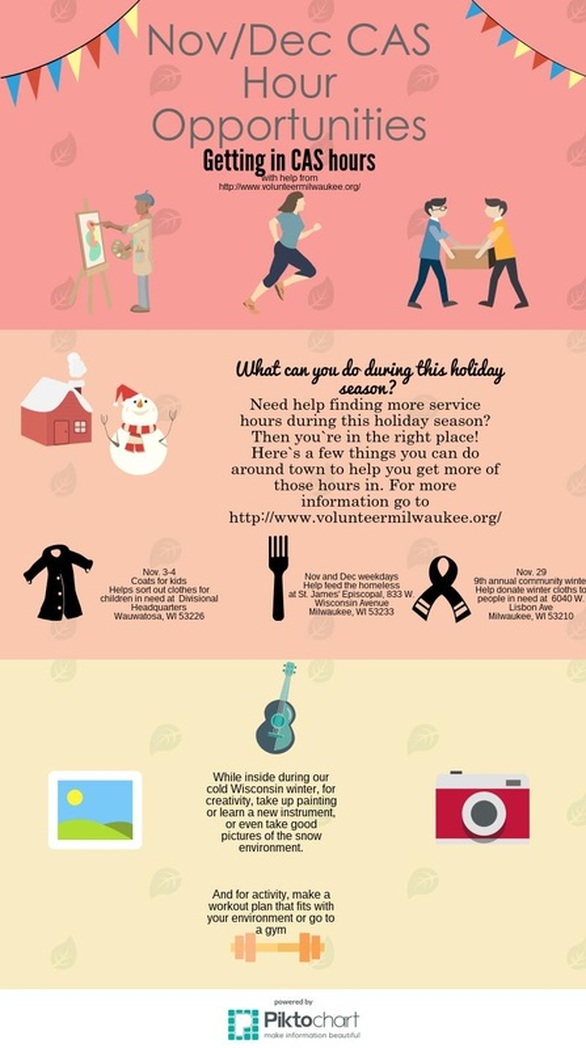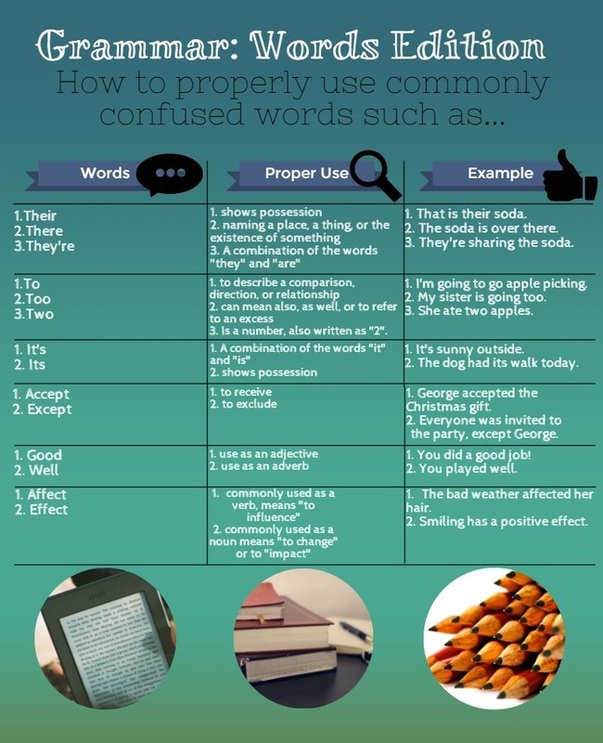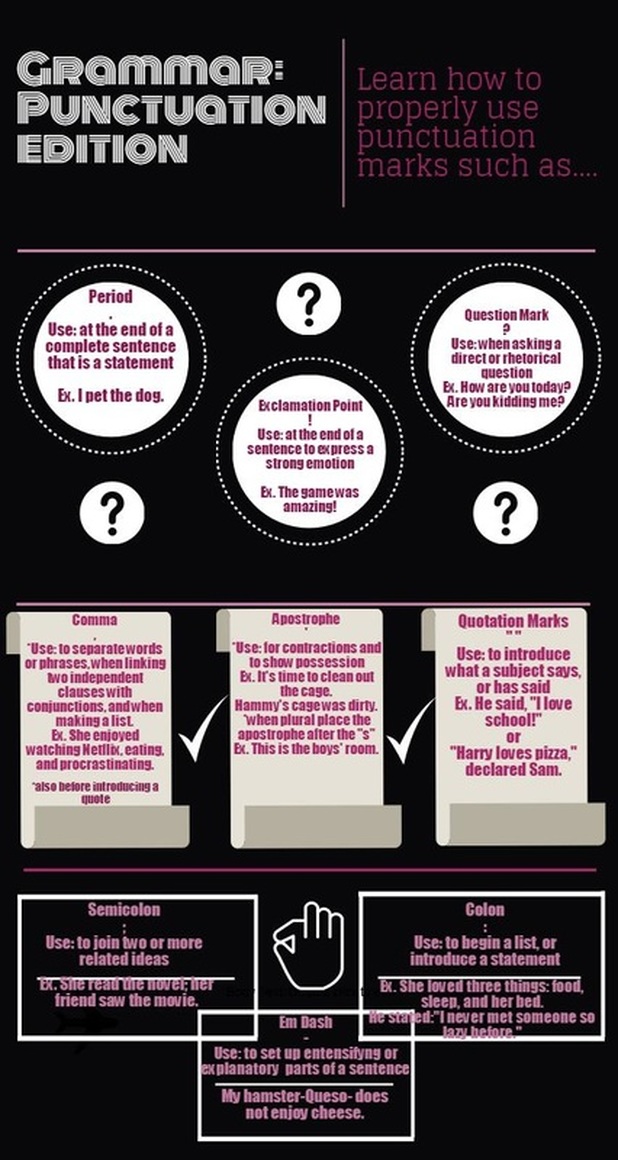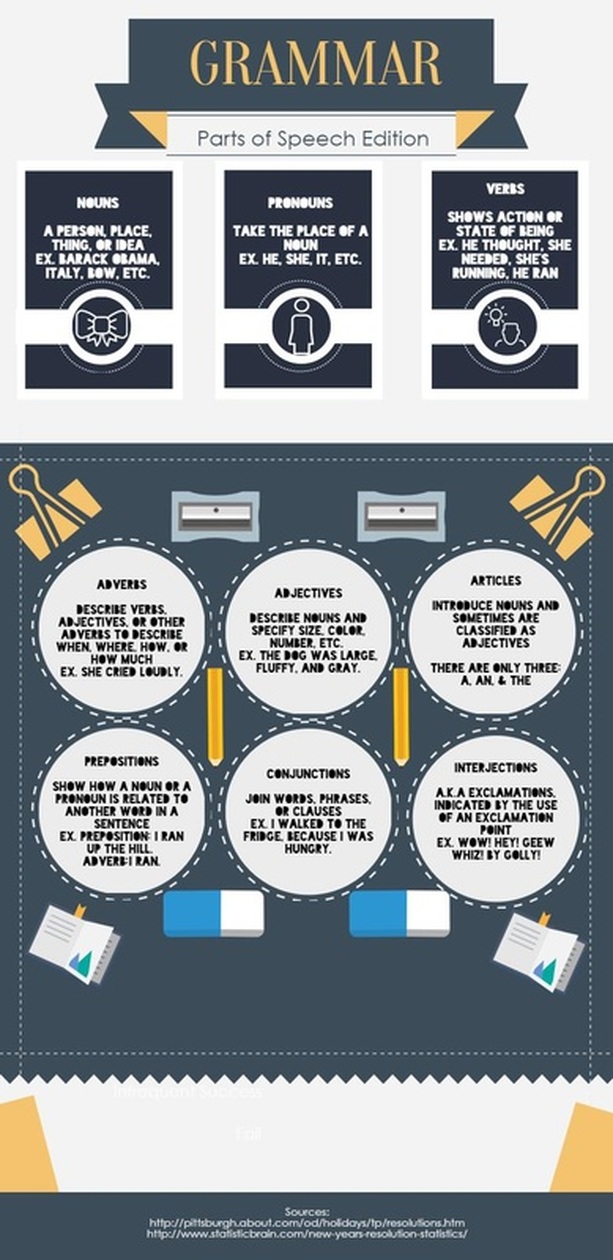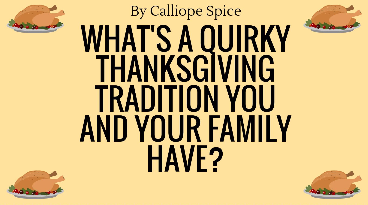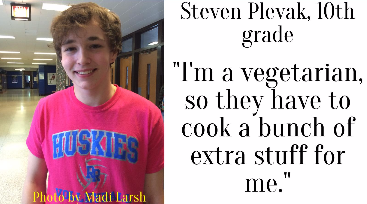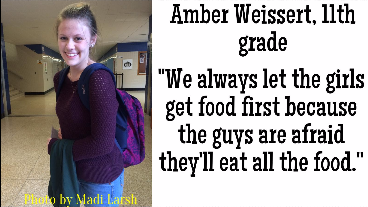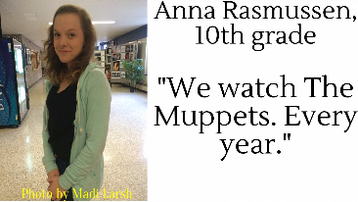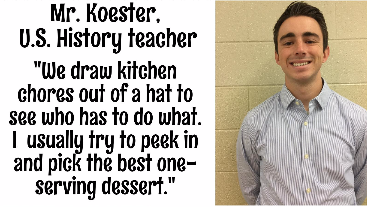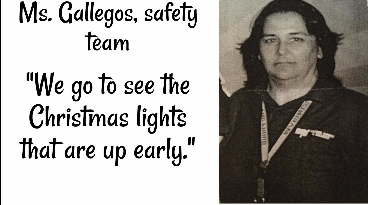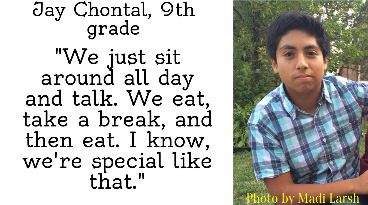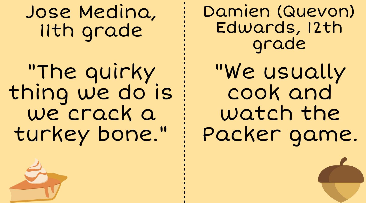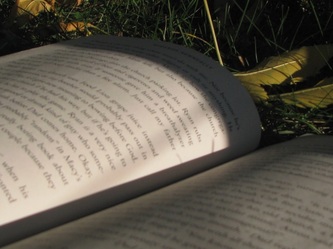features
Homecoming PHOTOGRAPHIC Timeline
IMAGES & CAPTIONS BY KATIE GILLINGHAM
OCTOBER 28, 2015
OCTOBER 28, 2015
Wasn’t the Eiffel Tower a neat touch? People took a lot of pictures over there! The lights made it stand out with a view like this.
Anybody join in on the Cha Cha slide? The Conga line? It was super fun, wasn't it?
Your announced 2015 Homecoming Court! Jesse Lago and Genesis Aviles! Congratulations!
Soon after that, the night came to a close, people cleared out, and it was the end to a fantastic night.
Soon after that, the night came to a close, people cleared out, and it was the end to a fantastic night.
Throw Away your Razors, boys, it’s Movember…
WRITTEN BY MADELYN DRURY & MORGAN STARK
OCTOBER 28, 2015
OCTOBER 28, 2015
|
Sean Koscielak
Photograph by Araceli Mendoza |
Any average joe can have any average beard, for any average reason. In 2003, it was not so average to grow out facial hair for only the month of November... But it seems to be now.
Movember originally started in 2003 in Australia, when two men decided to take up the challenge bringing back mustaches. The first year was rocky with only about 30 guys participating. The following year, the new foundation gained attention and raised over $40,000. The money raised was donated for a prostate cancer foundation of Australia. As the cause grows more each year, Movember expands to more countries. These countries include Canada, the US, and the UK. Overtime Movember became more recognized and raises awareness to the health issues that devastate more men each year. To this day, more than 649 million dollars has been raised,and more than 4 million people have participated. |
While interviewing Sean Koscielak (pictured on the left), a former teacher, he expressed that although he did not grow his beard initially for Movember, he did grow it out for one student and the former 8th grade class. In the past, Koscielak grew out his facial hair in high school and college years to raise awareness for Movember. In fact, his brother competed in competitions around Wisconsin for growing beards and won prizes for them. As well as himself, his friends and brothers also participate and sport many types of beards and mustaches in their daily lives- not only in Movember but year round.
Overall, Sean expressed the true difficulty of having a beard. "It takes me 6-7 minutes of extra time in the morning," he stated, discussing the time-consuming task of maintaining the beast. "I have to use oils," he went on. "I can't shampoo [my beard] or it kills it.” Despite the challenges presented by this choice in facial hair, it brings style to an ordinary face.
With that, stick with this topic until next newspaper release and see a special guest after one month growing out his facial hair, how will Movember change their appearance? How will their awareness change? And most importantly how will the school, and world as a whole change their awareness? See you next month!
Overall, Sean expressed the true difficulty of having a beard. "It takes me 6-7 minutes of extra time in the morning," he stated, discussing the time-consuming task of maintaining the beast. "I have to use oils," he went on. "I can't shampoo [my beard] or it kills it.” Despite the challenges presented by this choice in facial hair, it brings style to an ordinary face.
With that, stick with this topic until next newspaper release and see a special guest after one month growing out his facial hair, how will Movember change their appearance? How will their awareness change? And most importantly how will the school, and world as a whole change their awareness? See you next month!
The Publishing Predicament: Professional Opinions from Reagan’s Own
WRITTEN BY CORI KRONSCHNABEL
OCTOBER 28, 2015
OCTOBER 28, 2015
Publishing - that single word can fill any writer with dread. When most people think of the term “publishing,” they picture large companies with stern-faced representatives that refuse your story as soon as you come in the door. Others may consider self-publishing, where you have to do all the work and pay for everything. However, these aren’t the only two ways to publish something. In total, there are four types of publishing companies - traditional, vanity, subsidy, and self-publishing. Let’s take a dive into one of the most feared words in writing!
|
Traditional publishing is exactly what it sounds like; it’s the most classic way of publishing books. The first step writers take is submitting part of their writing to an agent. Nonfiction writers send a proposal that usually includes some sample chapters, and fiction writers send a manuscript of their work. Once an agent that is willing to represent them is found, they sell the book or proposal to actual publishers. If the publishers decide that they want to publish the work then the writer receives an advance sum of money. They will have to finish their actual book, but editors at the publishing house will help them go through all kinds of revisions. The publisher is the one that handles the book cover, printing, formatting and distribution of the book. The writer has little to no control of this. The publishing house may also handle some of the marketing aspect. Another name for traditional publishers is commercial publishers.
Subsidy publishing can be considered the midpoint of traditional and vanity. Writers that choose this type of publishing enter a partnership with their subsidy publisher. The writer is able to keep most (or in some cases all) of the rights and ownership of their work.
Subsidy is different from traditional because in traditional publishing authors are paid an advance; whereas in subsidy publishing the authors have to make a financial investment in the cost of publishing. In this case, the publisher is the one that handles all of the production and distribution, and they provide funds for both sales and marketing. Authors are able to earn royalties immediately.
Subsidy publishing companies are also less selective than traditional, so it’s easier to get a subsidy publishing deal. While vanity presses earn profits from printing books, subsidy publishers - just like traditional publishers - make their profit from book sales.
|
Vanity publishing has a bit of a bad reputation in the world of literature. With this method the writer is the one that pays to have their book published. Traditional publishers decide what books they send to the market, while vanity publishers don’t require any approval or editorial process for the writer to go through. Traditional publishers make their profit on selling books, whereas vanity publishers make profit on printing books. Sometimes vanity presses offer services such as editing, formatting, and cover design, but in most cases they do not. If a writer decides to do go through with vanity publishing then they are responsible for editing, designing, distributing, and marketing their work.
Last, but certainly not least, there is self-publishing. Self-publishing gives the most freedom to the author. The publishing company is the writer. Self-published authors are responsible for writing, editing, proofreading, creating a cover design, making a layout, distributing, and marketing their work. They don’t have to do it by themselves, though.
Many writers who do self-publishing get help from sites like Lulu.com, which is an online self-publishing website. Lulu.com was founded by a man name Bob Young, who had an unsatisfying traditional publishing experience. Essentially the site helps make the self-publishing process easier. It provides writers with tips, resources, articles, and even different forums filled with advice from other authors. Once writers publish a book using the site, Lulu.com will have their book available for sale online, on Lulu.com. Some authors tend to lean more towards self-publishing because they can work at their own pace and it isn’t as stressful as the other methods of publishing.
Even with all these facts and information is still hard to decide what method of publishing best fits you. Because there are so many things to consider, it was decided that some other information about the topic of publishing should be provided.
Three of Reagan’s own are published writers. They had to go through the difficult process of deciding what method of publishing
they would use. |
In an exclusive interview for the Husky Howler, they talked about their experiences with both writing and publishing, and how exactly the process went for them. Let’s see what they had to say.
How did you get into writing?
|
Yianni: I was inspired by the personal project actually, just to do something outside my comfort zone. I wrote a little bit in the past, so I just decided to see what I had in me.
|
Iliana: As a young child I have always indulged in reading at a more advanced level than most of my peers. I had a book with me wherever I went. You could say it was sort of my religion (and still strongly is). So, when people ask me what inspired me I say that it was the act of reading because without it I would have never been introduced nor fallen in love with the idea of my name someday being under a title of a book.
|
Kristen: It wasn’t particularly anybody that got me into writing. I do remember - this may have what got me into writing - in the fifth grade a friend of mine started writing this book about a dog’s perspective, like that was the narrator. I was reading it, and for some reason I had a really mean thought where I was like “I can totally write better than this.” So then she was like “No you can’t,” and to prove it to her I started writing and it kind of became a routine. I just wrote every day, and it started building off of all these things, like I started being introduced to all these amazing books. That’s when I started reading high school level books. There was Eragon, there was Mockingjay, and I think that’s how my writing started. It was this little competitive thing that actually turned into something that motivated me to do something that showed part of myself that you don’t usually show.
How long have you been writing?
|
Yianni: I mostly started with the personal project. I didn’t really write much before that. My personal project was based on bullying, and basically my novel is from the point of view of a teenager who goes through being bullied, and he has family issues, and there are different aspects of bullying that he deals with. The product of my personal project was my book, Nobody. It took me about seven to eight months to write it. The first six months were pretty much the first draft and then I was getting it finalized the last two months, just trying to get it all together and get it published. I started in the summer and ended during the school year. |
Iliana: It's difficult for me to decipher an exact time when I began writing because writing has always been a part of my life as much as reading has. I can't remember going a day without writing. The thought alone is a foreign one. I've been writing since the moment I was able to put pencil to paper. Whether it is was on napkins, scrap paper, gum wrappers, or practically anything of that sort I was writing. It comes into my daily routine as easily as breathing. |
Kristen: Just since the fifth grade. It really took off in eighth grade. I just started getting story ideas between fifth and seventh grade, but I actually started writing in the eighth grade and especially in high school.
Sometimes authors base their characters off of themselves, or parts of themselves. Are there any similarities between you and your characters? What about your friends or family and your characters?
|
Yianni: Not based off of me, but Jacob - the main character - has friends that are based off of my friends. My friends have maybe done things to inspire me or help me to make the story more personal. No one in my book is based off of anyone in my family.
|
Iliana: I get asked this question rather often and I'm not ever sure exactly how to respond to it. I think my characters often reflect attributes I wish to acquire rather than those I already have. Although I try my best to avoid creating characters based solely on those around me, I'm almost positive that I grant every character in my story a trait I admire most in people. This also includes flaws because those flaws are what make a character real and relatable to readers.
|
Did any part of your personal life affect how the story was written?
Did any part of your personal life affect how the story was written?
|
Yianni: I’ve always had a really big issue with bullying. I really stand up for kids who are bullied, because it’s really not the best thing to go through. It just breaks my heart to see kids who have to go through it. I makes me want to stand up for them whenever I can. |
Iliana: Writing has always been a safe haven of sorts for me as a child and still today as a teen. It was the one thing I knew I had the capability of doing and felt confident in doing so. Although there were no specific events leading to how the story was written I feel that boost in confidence when I wrote it definitely impacted my writing immensely. |
How did you publish your book? Did you use Lulu.com and self-publish, or was there a different way you did it?
Yianni: I did some research to see what was best out there. I found out that Lulu was pretty good so I just decided to use it to self-publish.
Yianni: I did some research to see what was best out there. I found out that Lulu was pretty good so I just decided to use it to self-publish.
Iliana: I actually went through a publishing company named HenschelHAUS. My grandfather, to whom the book is dedicated to, knew someone who knew someone. We offered them a draft and in return they offered to publish my book. Although it isn't a self-publishing company, I can definitely say that it was a bit tedious at times and that you must have an immense amount of patience to go through the process. But even through all that I enjoyed the experience all the same and would do it again any day.
Iliana: I actually went through a publishing company named HenschelHAUS. My grandfather, to whom the book is dedicated to, knew someone who knew someone. We offered them a draft and in return they offered to publish my book. Although it isn't a self-publishing company, I can definitely say that it was a bit tedious at times and that you must have an immense amount of patience to go through the process. But even through all that I enjoyed the experience all the same and would do it again any day.
Kristen: So originally I wasn’t going to go self-publishing, because a lot of it is hard work. You are your own editor, you are your own advertiser, publisher, so on and so forth. As I was looking I found out that usually you go through a traditional publishing, where you send out queries which is kind of like trying to sell your book like “Hey this is what my book is about - you should publish it!” Any query is hard, but poetry is really hard to publish. Most poets that I got in touch with - just random ones on the internet - say “I published ten books on Lulu or on Create Space and I make more money doing that then probably waiting and sitting for a publishing company to publish my work, when I could just be doing and putting out my work my own way.” So, I tried different self-publishing ones like CreateSpace, but for me that wasn’t visual enough for me to understand what my book would look like. So I just went with Lulu.
What are the pros and cons of the type of publishing you chose?
|
Yianni: The part of self-publishing that I liked was that it wasn’t that expensive. It’s definitely better for time - you have a lot more time to work with it. There wasn’t anything that I really hated about it. |
Iliana: I have never self-published, but I can say that with a publishing company you are advertised more which leads to a large amount of your books being sold. |
Kristen: Okay so the pro of it is that you get to control your book. What it looks like - I designed the front cover of it. I just took a photo of my knees and the pencil and set it up like that. I was able to write everything. The con of it was page setup. You have to set up your page specifically to the size of your book, which means you have to change your word document to different settings. It’s a big hot mess. I didn’t really want to deal with this. I had time, it was over the summer, so I called Lulu and I was like “Is there someone that can do this for me?” And they said “Yeah! We can do it for you!” I was like, “Awesome! What should I do?” They said, “This is what you need to do - you need to contact one of our packages, which is one thousand dollars. We can edit your book for that amount.” I was like “What? I don’t have one thousand dollars! I don’t even know if this book is going to make one thousand dollars! Why would I pay one thousand dollars?” So I just took the initiative and did it myself. I don’t think it turned out that bad. Another one of the cons is that since I’m a humble person I don’t like advertising myself. So when I went to sell my book I’m just kind of like “People shouldn’t know about my book, they should just buy it if they want to,” but no you have to sell the book. People won’t know about it unless you tell them.
Would you recommend your type of publishing to other authors?
Yianni: Self-publishing is a lot easier and you can get your work out their faster, so I would definitely recommend it.
|
Iliana: Although self-publishing sounds less stressful and tedious than going through an actual publishing company, I don't think I would ever attempt it seeing as to how great of an experience I had publishing through HenschelHAUS. You do reap a lot of benefits from it such as book signings and inside connections to the publishing world, so I would definitely recommend it to any other aspiring authors. |
Kristen: I would only recommend it to those that have the patience for it. It's a lot of independent work on the author's part, especially if you don't have the money to spend to make it perfect. However, you can still get quality work out of it. Also, it's a great first step into the publishing business. |
Did you end up selling as much as you thought you would?
|
Yianni: I had over 7,000 book purchases. I partnered with an organization called the Bully Free Hope Group. They put my book on their website, and it was for preorder, so that’s how I got all the purchases; and from the books that were purchased on their website I got an email from a girl who pretty much thanked me for the book because it inspired her to move past her comfort zone and talk to her family about things. It was nice to read that from somebody who was actually affected by the book. |
Iliana: It was a lot more than I thought I would sell considering I was scared absolutely no one would bother with it. |
Kristen: I thought I would sell a lot less. I have sold about twenty. To some people that isn’t a lot, but each book goes for ten dollars. That’s like two hundred right there. Plus for every book I get sixty to seventy percent profit. The rest goes to Lulu for me using their publishing; still, that’s over a hundred dollars. So I was really happy, I’m really satisfied, but I do have to figure out a plan to advertise my book more, because all this money is going towards college. |
What was the hardest part of writing your book? *contains spoilers for Yianni Antonopoulos’ novel, "Nobody"?
|
Yianni: The hardest time I had was on the ending. I wrote the ending as anybody can think of it to go one way or the other. It is open ended. So in the end of the book you can see that either Jacob lives and goes past his problems or that he is watching down on you as if he is in heaven and that he isn’t here anymore. It’s however you interpret the story. For any kind of writing, I think developing the characters is hard. You really have to become the character and get into what are they thinking and doing. There’s a lot of thought that goes into it. |
Iliana: The hardest part of writing my novel would be the editing. I despise editing. I see the word 'edit' and die a little inside because editing means that you will have to part with your work. You have to rip all emotional attachment from it and beginning hitting that dreaded delete button. Thinking of it right now actually stresses me out. |
Kristen: Being able to share my emotions and thoughts and knowing people in my life that may get offended or hurt by my words. There are some writers out there that haven't even begun to produce their work and another fear of mine was that what if I was shipping off my work too early in the process? What if I just sound like a pretentious, whiny teenager that has no depth like how she sells her book? A lot of thoughts cross through my mind like this but I view it as a learning curve. If people think it's bad, I need to learn how to handle that because with being a writer, labeling yourself as a writer, it's just in the job description that you're going to possibly get more bad reviews than good. The question is though which of those bad reviews can you utilize to make your work in the future better. But, touching back on who may read it; I touch on a lot of stuff, love, relationships, family and I'm not going to lie some of it involves me being pushed aside, but that was the motivation for me to write the poems. So, if they read it and don't like it that is their own fault because if you don't want your ugly side to be shown to the world than don't have one in the first place. Plus, the one person I'm still waiting for to read my book hasn't and I don't think they ever will so I'm not too shy anymore about how I write about people and about myself. I know I'm not the best person in the world but I try. So, I will show my failures in these poems and stupidity and I'm not ashamed because I'm still learning.
What story genre do you enjoy writing in the most?
Yianni: I like reading fiction but I wouldn’t really write it. I really enjoy writing non-fiction.
Iliana: My absolute favorite genre to write in is fantasy, especially dark fantasy. There’s something thrilling about it as it enables me to let out my inner child. I believe children have the most fascinating imaginations that should be taken advantage of at all costs, and I’m proud to say that I have held on to that part of me as I begin to continue growing up.
Kristen: I like writing about realistic fiction. It can be so absurd and you can think, this can't possibly happen in real life, but the reality of it is is that our world is ridiculous crazy and fascinating. You don't have to write sci fi or fantasy to escape the world when those things are right at your fingertips or outside your door. When I write realistic fiction I try to keep that in mind because what seem unrealistic and absurd to us is someone else's reality.
Would you write something from that genre and try to publish it again? Why or why not?
|
Iliana: I’m actually in the works of writing yet another one of my fantasy driven books. Although it’s definitely not ready to publish, I know once it’s ready I will take another shot at publishing. I believe it’s an incredible feeling to have your work on display for others to read and enjoy. I enjoy writing and publishing as much as I enjoy seeing and hearing the reactions of readers who’ve taken the time to look over my writing. |
Kristen: I'm already working on a couple of stuff, but I won't be doing anything with it til after my senior year. Sadly I just don't have the time so I try to use my summer to get that done and accomplished. |
Writing is considered one of the fine arts, yet many high schools do not offer a separate class for creative writing. Do you believe that it’s important to provide a creative writing course for students?
|
Iliana: Yes. Yes. Yes. I do believe that it's extremely important to provide a creative writing course for students. I cannot express to you how many times I've been disappointed to know that a school doesn't offer it. In fact, it's astounding to find that they don't. I just read an article the other day revolving around this idea and it almost brought me to tears because we have come to a point where we drill this idea into the minds of students that writing has some sort of set structure. We give them an outline, tell them follow this exact structure for every piece of writing you do, and that if they add some creative sort of edge they are wrong. Creative writing has no boundaries and it shouldn't. Shakespeare definitely didn't think so.
|
Kristen: To be honest I think writing in general, as least at Reagan, is talked about enough to give that push to anyone that is willing to take it to get them into creative writing, if they want it. So, I don't think we necessarily need a creative writing class. I think one of the amazing things about writing is that I feel it's one of those things where if you want it bad enough you'll fight for it. And creative writing is one of the ultimate tests of that. I've seen a common theme about writers when they first begin - they are the one's to discover it first. To discover the soft yet powerful words in the books and world around them. It's so intoxicating that they just need more of it which leads them to finding guidance with teachers, peers, and other writing to give them the tools they need to utilize this overwhelming need to express whatever they want. That’s why writing is powerful, and that is what makes it human and real. If you make it into a class forcing kids to write for a grade in high school they lose that humanity. If they want it they can find it through other books and they can most certainly take it in college, I just don't think it would be an amazing idea to have a high school class in creative writing.
|
And there you have it! If you are interested in improving your writing abilities, talk to Mr. Kuehl, head of creative writing club. The club meets almost every Wednesday in room 208 from 3:00-3:30.
'Tis the season for Creativity, Activity, and Service
WRITTEN BY JEROMY WILL
OCTOBER 28, 2015
OCTOBER 28, 2015
School to work program
WRITTEN BY ALEXXUS HART
OCTOBER 28, 2015
OCTOBER 28, 2015
The School to Work Program is an opportunity for students who are eligible to engage in meaningful work-like experiences. These experiences are designed to provide them with an opportunity to build employment skills in a supported setting. While in this program, students also learn more about their individual strengths or weakness and likes or dislikes. This program has a variety of formats and students can work in diverse settings throughout Milwaukee such as Alverno College, Sinai Hospital, Nurturing Nook, and much more!
Reagan currently has ten students participating in the School to Work Program this semester.
Four students this year have work placements at Mitchell Elementary, where they serve as teachers’ aides. While part of their day consists of being a student at Reagan, the other part consists of working with 20+ 1st and 2nd graders.
- To see if you're eligible for this program or would just like to see the learning of those in the program you can visit Ms. Wilkening in room 233
- There are no age requirements for the program but students who participate in this program are generally juniors, as it works best with their schedules. Occasionally there are seniors and sophomores that are also involved as well
Here are interviews of three students who are in the program and what they think about the program:
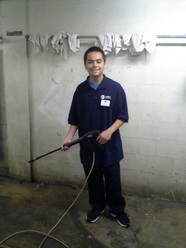 Image by Terri Nolan
Image by Terri Nolan
Isaac Ceballos, an 11th grader, works at Manor Park which is a residential facility for the elderly. His duties are to work in the laundry facility, fold towels, and assist the residents. This has been his first step working at an actual job. He has been doing really well because the instructors help and show him how to do certain tasks to their expectations. He believes this job will help him in the future because it's helping build connections with other adults in the community. He also thinks it's a great attribute to put on his resume.
Isaac began talking about the program and how it has helped him figure out a career path, he said, “Yes - I think so. This program has helped me become more comfortable interacting with people. This job at Manor Park has shown me that I want to work with people in the future.”
The final question I asked Isaac was what he enjoyed most about the program and his job. He responded, "I enjoy talking to the residents and being social with them. Sometimes I push them in their wheelchairs, which makes me feel good because I can help them.”
Isaac began talking about the program and how it has helped him figure out a career path, he said, “Yes - I think so. This program has helped me become more comfortable interacting with people. This job at Manor Park has shown me that I want to work with people in the future.”
The final question I asked Isaac was what he enjoyed most about the program and his job. He responded, "I enjoy talking to the residents and being social with them. Sometimes I push them in their wheelchairs, which makes me feel good because I can help them.”
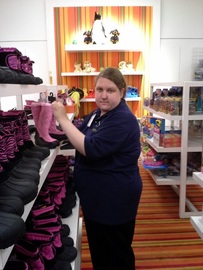 Image by Marissa Wilkening
Image by Marissa Wilkening
Julianna Luty is a 12th grader that works at Boston Store. Her duties include folding clothes, organizing shoes, shelving, putting clothes on hangers, and maintaining and keeping a clean environment for customers.
Julianna said, "My job could help me get a future retail job because it helps me learn about organization and following directions. I think it will help me with other future jobs, as I am learning about responsibility and professionalism."
I then asked if the program helped Julianna figure out a career path. She responded, "I think this program will help my career path because I'm able to talk and interact with other people. I am learning a lot of social skills that are important to have in the workplace. I am also learning how to ask lots of questions when I am unsure of how to do something."
The things Julianna enjoys most is helping the customers. She also likes learning how to do different duties all around the store.
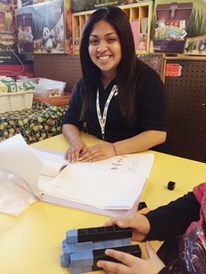
Maritsa Madrigal is a 12th grader working at Mitchell Elementary school. I asked Maritsa what she did in her job, and what it is teaching her that prepares her for the future. She said, “I work with children ages 5-6. This job is teaching strategies for working with this age group. This experience will help me in the future because it is giving me practice on how to deal with young students and interact with them."
She continued, "While I am interested in working in the healthcare profession, my experience at the elementary school is helping me learn how to interact with young kids and how to be a professional."
Maritsa said, "What I enjoy most about this program is that I am kept so busy and entertained with the students I am working with. We are always doing something and it is very rewarding to be able to help young students learn.”
She continued, "While I am interested in working in the healthcare profession, my experience at the elementary school is helping me learn how to interact with young kids and how to be a professional."
Maritsa said, "What I enjoy most about this program is that I am kept so busy and entertained with the students I am working with. We are always doing something and it is very rewarding to be able to help young students learn.”
SOlving grammar Errors one Infograph at a Time
WRITTEN BY VALERIE MECHA
OCTOBER 28, 2015
OCTOBER 28, 2015
Thanksgiving is not the only time for turkeys at reagan
WRITTEN BY CLAUDIA SPICE
OCTOBER 28, 2015
OCTOBER 28, 2015
 Image provided by Lyn Smith
Image provided by Lyn Smith
The rush of morning Reagan traffic does not seem to phase a particular group of turkeys that roam up and down S. 20th street as students arrive for school. Every few mornings, a flock of three turkeys walk past Reagan and through neighbors' yards.
"They sit in the middle of the intersection all the time," says Reagan junior Austin Kurtz. This unusual sight in the city has become a normal occurrence, but has definitely left some people questioning why they may be there. "I wonder how they can appear and disappear everyday," Austin adds.
Turkeys are not typical in cities, however the urban turkey populations have risen in recent years. According to Dianne Robinson, a biologist for the Wisconsin Department of Natural Resources (DNR,) the predation and hunting threats are low in populated areas, so turkeys began to realize they can take advantage of both that, and the wider range of food sources.
"They can adapt to urban areas if they have all the right resources. Acorns are a major food source for them," explains Elizabeth, a representative from the DNR. This offers an explanation as to why they are seen so often.
Also, turkeys tend to stick together in their flocks, which explains why the same group is often seen together. According to Robinson, they are well known and "frequently roam Layton Avenue and through Greenfield."
With the recent turkey spike, "this flock is not the only group. I know of sizeable flocks around the UWM campus, [and] in Wauwatosa and River Hills," continues Robinson.
Wisconsin is big on wildlife, but it is normally birds and squirrels that scurry through the city streets, not turkeys. Therefore, they are definitely a sight to see. "I personally enjoy seeing them. I think they are cute and add to the amazing fall vibes," says Leo Ornelas, a junior at Reagan.
Some students are not as open to the turkeys, however. "They're scary in way. I was walking to the bus stop once, and encountered three turkeys. Although I didn't get attacked, those birds are so big and it makes you so uncomfortable. It's like an overgrown chicken," says Joseph Xiong, a junior.
It is not necessary to see these turkeys as a huge threat, but everyone should proceed with caution when approaching them. Robinson suggests that "people look at and take pictures from a safe distance, and scare a turkey away if it approaches."
"Generally, turkeys outside of urban areas are very shy to humans, but some urban turkeys have become 'habituated’ people and may have lost much of their fear of humans," says Scott Diehl, the director of Wildlife Rehabilitation for the Wisconsin Humane Society. "It is best to give them their space," Diehl adds.
So, urban turkeys are gaining in both number and popularity. The Reagan turkeys have been spotted so often that they are getting their own spread in this year's yearbook!
Looking back on past Thanksgivings
WRITTEN BY CALLIOPE SPICE
OCTOBER 28, 2015
OCTOBER 28, 2015
Adhd AWARENESS month
WRITTEN BY JACQUELINE JONES
OCTOBER 28, 2015
OCTOBER 28, 2015
October is ADHD Awareness Month and a big topic around the world. Many things are unknown about ADHD by people despite the fact that there are more than 3 million newly diagnosed cases a year. ADHD stands for Attention Deficit Hyperactivity Disorder, and people can be diagnosed with it at all ages but it affects males more than females. There are many symptoms that come with having ADHD, but no one has to let these symptoms control their lives.
The are many people in the world with ADHD but not many people know what that is, never less know the symptoms of it. According to everydayhealth.com, Some symptoms in behavior may be aggression, fidgeting, hyperactivity, persistence, and lack of restraint. Others include absent-mindedness, difficulty focusing, forgetfulness, problem paying attention, or short attention span and affects to mood is anger, anxiety, boredom, excitement, or mood swings. Depression or learning disability is also common if you have ADHD.
There are many problems that come with ADHD but there are strategies that can help. Talking to a therapist or counselor can help get out pent up frustration. Having ADHD can make it harder to control your anger so having something healthy to release it on is a good thing - even if it is just talking. Having pent up anger is not good and can lead to explosive outbursts, so releasing anger in a health way will help to prevent these situations. Getting in control of your emotions and actions is the important thing and what matters the most and what helps. Think about your education when you want to slap that guy in the face because of what he said. Tell the teacher, even if it's snitching, because it will be better than being suspended and missing a handful of assignments.
Having ADHD is not a bad thing although it can be a burden at times. If you control of yourself and your temper, you can be just as successful as Justin Timberlake, Will Smith or Michelle Rodriguez, who have all been diagnosed with ADHD. Having ADHD may make it harder to focus in school, but it doesn't make it impossible to be successful.
60 Things to do in fall
WRITTEN BY MADELYN DRURY & MORGAN STARK
PHOTOGRAPHY BY MORGAN STARK
PHOTOGRAPHY BY MORGAN STARK
|
Jump in a leaf pile Decorate pumpkins Carve pumpkins Go pick pumpkins Make cookies (chocolate chip, oatmeal, any kind) Make caramel apples Have an apple pie (make it, bake it, eat it!) Drink Hot chocolate
Have an Offline day Bob for apples Give thanks Brush up on your history of Thanksgiving Go Trick or treating Attend a Haunted house Watch Macy's Thanksgiving Day Parade Take an Early morning walk Host a food drive
Pick wild flowers Go camping Play basketball Watch old movies in black and white Attend a Play/Musical Enjoy Nature Watch a Bucks basketball game Enjoy the choir concert at Reagan |
Go Apple picking.
Make Leaf art Take a Hayride Go through a Corn maze Watch Football (Packers, Badgers, Reagan) Roast pumpkin seeds Go on a hike Volunteer for a local charity Watch A Charlie Brown Thanksgiving
Watch a movie (action, romance, the list goes on) Watch the sunrise Enjoy a bowl of soup Do a DIY project Light some candles Rake a neighbor’s yard Walk in the rain Build a fort Take a bike ride Read a good book Take pictures Eat Pumpkin pie Take a painting class Take a pottery class Go see the Addams Family musical Or A Wonderful Life the musical- at Fireside Theatre See the Christmas tree in Cathedral Square Take a dance class Try out for one of Reagan’s winter sports |
How Your Technology hertz you
WRITTEN BY LEONARDO ESPINOZA
OCTOBER 28, 2015
OCTOBER 28, 2015
Change is Constant
Smartphones - helpful pieces of technology that can also destroy your health.
Yes, they help us keep connected to our friends, but they may be the cause of some health problems and even some mental issues. Don’t worry, it is (mostly) fixable. However, some are permanent.
How Your Smartphone Hertz Your Mind
Smartphones have become not just a method of connection to the world, but also a part of our everyday lives. Many can become addicted, and it can create anxiety. There can be stress when you text someone and are expecting an immediate answer. Your body starts to play tricks on the mind. If that weren't enough, one can feel the phone vibrate out of nowhere. 68% of Americans have this issue of feeling the cell phone vibrate out of nowhere. They are called “phantom vibrations” according to the website Greatist. They are irreversible, unless you give up your smartphone. Even something as small as that can contribute to further health problems that may be life threatening; you can fix it by doing other activities to clear your mind from the cell phone.
How Your Smartphone Hertz Your Skin
Believe it or not, your phone can actually hurt your skin. Smartphones can make you allergic to cell phones. Think about it. What places have you touched that may not have been clean, and then you touched your phone? Those viruses and bacteria are on your phone. That railing you touched when going down the stairs before texting your friend could have millions of bacteria. Then you call someone with your smartphone and that bacteria is now on your face. Your phone is so germ-filled that it can give you acne, eczema, and other blemishes. All those can make you allergic to your phone and filled with zits all over your face. To help prevent this, just clean your phone everyday. Stores sell screen cleansing solution for a reason. Besides, it also leaves your screen really clean. Another solution would be to talk to the person in person, try video chat, and text them. Essentially, calling is the only thing bad for your skin.
How Your Smartphone Hertz Your Bones
Yes, your phone can hurt your bones. Do you text a lot? While texting, reading on your phone, and doing pretty much anything on it, you probably are inclining your neck forward. Once in that direction, it can cause it to become hunched, and it can become permanent. Among the symptoms is “Text Neck,” when your head is excessively forward The extra 60° it moves forward adds an extra whopping 60 pounds to your head making it painful. That adds pain to your neck. Your fingers are also at risk. As already said texting is horrible for your bones. Texting creates a text claw. Yes, a claw. This happens by the repetitive motion your hands make when texting. It then leads to tendonitis, the inflammation of the tissue connecting bone to muscle, which causes hand and wrist pain. This can be solved by using other forms of communication.
How Sitting and Using Technology Hertz Your Health
This might seem really hard to believe but sitting too much can hurt you. It seems weird, but just think about it. You have veins everywhere, so when you sit, you are suffocating them. Using any piece of technology while sitting for a long time is bad for your health.The problem is so bad it can actually give you blood clots in a long term effect from the veins being suffocated. It can also lead to heart disease. Some of these include: obesity, uneven cholesterol levels, high blood pressure, and that can lead to some worst health risks. You know the obvious heart attack, or diabetes. However, you don’t have to quit sitting all you have to do is to make some changes. Instead of sitting for long periods of time try and stand up take a walk to do something and return with new energy.
How a Computer Keyboard Hertz Your Hands
Did you know that by someone typing this article something was wrong? Your computer keyboard might help you type in words and inform you, it can also give you carpal tunnel. Carpal tunnel is when your nerve gets caught between two or more bones and it is very painful and hard to fix. This condition can only be fixed through surgery,but what causes it in the first place? When you type, your wrists have to bend. That repetitive motion can cause the wrist and hand pain, those are early reminders that you have possible carpal tunnel. Don’t worry, if your chair makes your hands be at the same level as your keyboard, then it is fixed. If not, then fix it if you use the computer for long periods of time.
How Your Screen Hertz Your Eyes and Other Things
Looking at the screen is hurting your eyes as we speak. No you don’t have to stop using your screen; the solution is really easy. Looking at the screen you are seeing a bright light that can really cause damage. The dark text in the light screen makes you strain your vision which leads to muscle spasms in your temples. Not only that, but it can also lead to what TIME Magazine describes as Computer Vision Syndrome. It includes symptoms such as eyestrain, blurred vision, and dry eyes. These are not nice symptoms, and the problem can progress. However, they are preventable. The way to prevent them is to take the 20/20/20 rule. Every 20 minutes, take a 20 second break from screens, 20 feet away. That way your eyes will rest and you will be able to not suffer from this.
In the End…
In the end, we can’t live without technology. Technology is a vivid part of our lives. It may not be perfect and may be bad for you, but we cannot forget that the issues are treatable. We can’t become technophobic just because we become scared of the issues these things cause, but we can become aware and make informed decisions of when to use and not use the technology
"Health and Technology." Digital Responsibility. N.p., n.d. Web. 10 Oct. 2015.
Holmes, Lindsay. "Sneaky Ways Technology Is Messing With Your Mind." Huffington Post. N.p., 12 Dec. 2014. Web. 10 Oct. 2015.
"19 Worst Tech Related Health Risks." Greatist. N.p., n.d. Web. 10 Oct. 2015.
